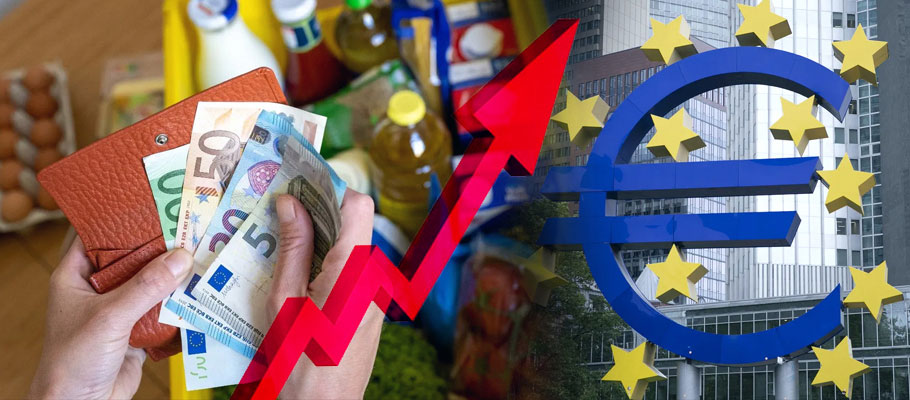
Published: July 3rd, 2024
A new print from Destatis shows headline CPI inflation in Germany fell to 2.2 per cent year-on-year in June, a drop from 2.4 per cent in May and under the consensus forecast of 2.3 per cent. The month-on-month comparison held steady at 0.1 per cent for the second month in a row, confounding expectations of a 0.2 per cent rise.
An analyst note from Berenberg said that declining German inflation, held against similar recent prints in France and Spain, ‘will give the ECB comfort to announce its next interest rate cut in September’.
A nationwide subsidy for public transport that took effect in May 2023 meant German transport costs pushed up headline inflation in May 2024, imposing what economists call a base effect. Removing that one-off from statistical measurements took inflation back to levels seen last March and April.
Having said that, inflation is falling at a very slow rate, and Berenberg notes that some ECB Governing Council members may be inclined to caution when deciding how quickly to resume rate cuts.
September will also see the release of new ECB forecasts. A softer inflation forecast could provide the bank’s Governing Council with a stronger argument in favor of another rate cut.
In August 2023, an analysis by Commerzbank said EUR/USD faced a near-term pullback below 1.11 thanks to ECB policy signals. However, better times for EUR bulls were on the horizon as a Eurozone recovery was likely be in full swing by year’s end.
‘We expect to see strong US data in the coming weeks relative to the Eurozone, which suggests that traders are pricing in higher expectations for another rate hike by the Fed. 'When that happens, the terminal rate will make the Dollar attractive against the Euro.’
Consecutive economic data prints exceeded consensus expectations, suggesting America’s economy was more resilient than forecasters expected. Commerzbank analysts were confident that the Federal Reserve would tackle inflation and sidestep a recession at the same time, an expectation that eventually came true.
The changed dynamic raised the odds of another rate hike in September 2023, pushing up Dollar exchange rates as a result.
But the bank’s analysts added that Washington and Frankfurt were close to negotiating a terminal interest rate, so moving a few basis points in either direction was unlikely to be a game-changer.
More important was what would come next, namely who would cut interest rates first, and to what extent.
Commerzbank economists said the Eurozone’s economic doldrums would improve towards the end of the fourth quarter.
At the start of 2023, ING Bank said EUR/USD had regained a level not seen since June 2022 after extending a strong recovery. A stronger Euro was finding support from Eurozone energy markets and a retreat by the Greenback driven by economic data. ING said it believed further gains were possible.
The pair opened the new year in retreat against a recovering Greenback, but after a retracement it leapt to a multi-month high on Monday 9th January, as forex traders quickly discounted rumors of an end to the US Federal Reserve's interest rate hiking cycle.
In a note to investors, analysts at the Dutch bank’s FX analysis unit said the pair had been ‘impacted by a Dollar sell-off and market bias could send it even higher. We are seeing parallels with the summer of 2007 when a slowdown in America’s housing market gave rise to expectations that the Fed would have to take its foot off the gas.’
Reviewing the price action that dominated the pair that year, ING said American two-year bond yields disintegrated to 2.6 per cent after experiencing trade in the 4.5 to 5 per cent range for the first half of the year. By December 2007, EUR/USD had rallied back by 10 per cent.
The Greenback tracked American yields higher in 2022 as global investors looked for better returns, therefore USD would be expected to retreat if this bond market dynamic went into reverse. ING says this is currently what’s happening.
The ECB said in December 2022 that it was ready for two more interest rate rises of 50 basis points, catching investors off-guard as they were gauging whether Frankfurt would slow down.
The US Fed then signaled that it would ease back soon. Forex traders started looking for the next 25 basis point hike, which was below what the ECB seems to have ‘priced in’.
In June 2022, EUR/USD was trying to climb out of a trough that saw it sink to five-year lows. EUR needed intervention from the European Central Bank (ECB) to beat an already hawkish Dollar market and sustain its recovery momentum ahead of the latest US inflation data print.
The single currency gained substantial support from a hawkish market that re-priced its expectations for ECB interest rate action in advance of the central bank’s late June policy meeting.
The meeting announced the end of Frankfurt’s last and longest running quantitative easing (QE) programme, while providing insights into the future path of European interest rates.
However, forex traders were focused on anything that signaled the ECB’s likely policy direction in July and September, particularly any guidance about the lift Eurozone interest rates could get in July.
In a note to investors, Barclays European Economics Unit said that EUR/USD could rise in the Summer ‘thanks to a more hawkish European Central Bank coming out of Friday’s meeting and a weaker Dollar. In that scenario we believe upside resistance at 1.0789 will be tested.
‘We will be closely monitoring post–meeting communications from the June meeting for indications that the tightening cycle is going to become more aggressive. There is even a small possibility that the ECB decides to raise rates this week.’